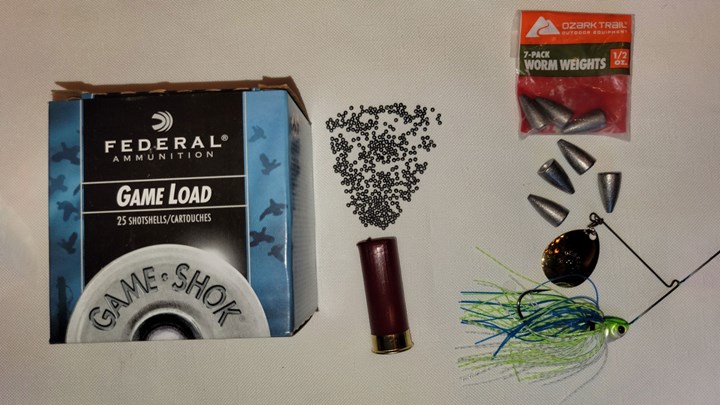
by Karen Mehall Phillips - Friday, September 23, 2022

Hunters and shooters welcomed last week’s U.S. Fish and Wildlife Service announcement regarding its final rule to increase hunting and fishing access on 18 national wildlife refuges for 2022-2023—until they got to paragraph No. 6. This is where it slipped in its other new rule: a ban on lead ammunition and fishing tackle at some or all of these refuges beginning in 2026. So, while the USFWS’ final Hunt Fish Rule for 2022-2023 increases access opportunities by providing 38,000 additional acres for public recreation within the federally managed National Wildlife Refuge System (NWRS), sportsmen are calling it as they see it: a backdoor phaseout of traditional lead products.
The NRA and other hunter-backed groups alerted sportsmen to the USFWS’ lead ban proposal on June 9 when it published a notice on its two proposed rules in the Federal Register. While the notice said hunting and fishing opportunities could be expanded on as many as 19 national wildlife refuges, the plan included a proposal to phase out ammunition with lead components—despite that lead ammunition does not negatively impact wildlife populations as anti-hunters claim.
On June 13, the NRA Hunters’ Leadership Forum (HLF) posted a story noting how the USFWS claimed the lead ban proposal was “based on the best scientific data available,” yet there is no data that shows traditional ammunition is causing population declines for any wildlife species at any wildlife refuge. As the NRA Institute for Legislative Action (NRA-ILA) noted, “Anti-hunting and anti-gun extremists ignore the science and misinform policy makers and the public on the effects of extremely small amounts of lead.” Many of them also say that alternative ammunition is inexpensive and readily available, which also is not true.
Yet for years sportsmen have witnessed attacks on lead ammunition by anti-hunting groups whose ultimate goal is to ban hunting. Unfortunately, these groups also ignore the consequences to wildlife conservation that lead ammunition bans would bring.
According to NRA-ILA, a decrease in the purchase of traditional ammunition would adversely affect wildlife conservation funding. This is because hunters and target shooters remain the largest supporters of conservation through excise taxes levied on ammunition, firearms and hunting equipment by the Pittman-Robertson (P-R) Act of 1937. Eighty-five years later, not only has it resulted in state fish and wildlife agencies receiving more than $15 billion in funding but states received $1.5 billion in 2022 alone, marking the most funding for any year to date. It’s no surprise that 80 percent of the funding comes from the manufacturing of firearms and ammunition thanks to America’s 32 million recreational shooters, millions of whom are all-American hunters who use lead ammunition.
Explaining its position, the USFWS announcement notes, “The Service remains concerned that lead ammunition and fishing tackle have negative impacts on both human health and wildlife and will continue to evaluate their future use on Service lands and waters through a transparent public process.” Its final rule does not include opportunities to increase the use of lead on refuge lands and waters beyond the fall of 2026. It says the Patoka River National Wildlife Refuge will require non-lead ammunition and tackle by fall 2026 while eight other national wildlife refuges—Blackwater, Chincoteague, Eastern Neck, Erie, Great Thicket, Patuxent Research Refuge, Rachel Carson and Wallops Island—have begun analyzing the phaseout of lead ammunition and tackle and plan to propose the regulatory requirement for non-lead ammunition by the fall of 2026. Watch for that move in the USFWS’ proposed annual rule for 2023-2024.
But then the USFWS circles back to access: “The Service is fully committed to continuing to provide important access for hunting and fishing opportunities on national wildlife refuges.” New NWRS opportunities opening up for the first time include: turkey hunting at Turnbull National Wildlife Refuge in Washington; upland game and big game hunting at San Diego National Wildlife Refuge in California; and migratory game bird, upland game and big game hunting at Great Thicket National Wildlife Refuge in Maine and New York.” For the complete list of all new or expanded opportunities, click here.
On a positive note, the USFWS announcement recognizes that “hunting, fishing and other outdoor activities have contributed more than $156 billion in economic activity in communities across the United States in 2016, according to the Service’s National Survey of Fishing, Hunting and Wildlife-Associated Recreation, published every five years.” It added that more than 101 million Americans—40 percent of the U.S. population age 16 and older—pursue wildlife-related recreation, including hunting and fishing. Yet the Biden-led USFWS is still opting to trade sportsmen’s access for a ban on traditional lead ammunition, disenfranchising the millions of sportsmen and women who support and fund conservation.
In scanning the comments from other hunter-backed groups, the Congressional Sportsmen’s Foundation makes a great final point on the USFWS’ “mixed bag” announcement. “The U.S. Fish and Wildlife Service is the top federal agency dedicated to conserving our nation’s fish, wildlife, and their associated habitats. As such, it is critical for FWS to follow substantiated science when making fish and wildlife management decisions, including decisions surrounding method of take. Unfortunately, the final Hunt Fish Rule does not appear to follow the science that is the foundation of the agency.”
While sportsmen certainly appreciate and commend the USFWS for expanding access within the NWRS—as the lack of access to land is a main reason sportsmen drop out of hunting and fishing—the agency is openly sidestepping the science. Speaking as a hunter, who among us wouldn’t be concerned over the USFWS’ move to arbitrarily restrict longstanding methods of take within the NWRS?
E-mail your comments/questions about this site to:
[email protected]
